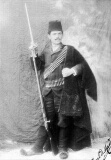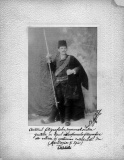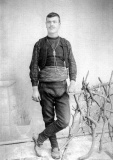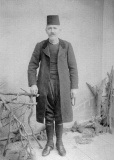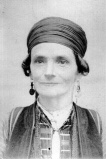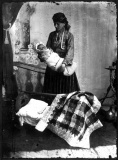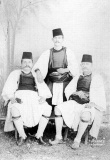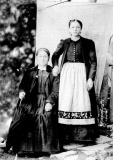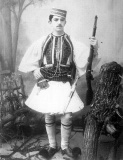Difference between revisions of "Yanaki and Milton Manaki"
Sorindanut (talk | contribs) |
m (Text replacement - "imagesize = 342px" to "imagesize = 338px") |
||
| (33 intermediate revisions by 2 users not shown) | |||
| Line 1: | Line 1: | ||
{{Infobox artist | {{Infobox artist | ||
|image = Ienache manakia.jpg | |image = Ienache manakia.jpg | ||
| − | |imagesize = | + | |imagesize = 338px |
|caption = Photo of Ienache Manakia, 1917. | |caption = Photo of Ienache Manakia, 1917. | ||
|birth_date = {{birth date|1878|5|18|mf=y}} | |birth_date = {{birth date|1878|5|18|mf=y}} | ||
|birth_place = Avdella, Ottoman Empire (today northern Greece) | |birth_place = Avdella, Ottoman Empire (today northern Greece) | ||
|death_date = {{Death date and age|1954|5|19|1878|5|18|mf=y}} | |death_date = {{Death date and age|1954|5|19|1878|5|18|mf=y}} | ||
| − | |death_place = | + | |death_place = Thessaloniki, Greece |
}} | }} | ||
{{Infobox artist | {{Infobox artist | ||
|image = Milton manakia.jpg | |image = Milton manakia.jpg | ||
| − | |imagesize = | + | |imagesize = 338px |
|caption = Milton Manakia in a scene from the movie ''Camera 300''. | |caption = Milton Manakia in a scene from the movie ''Camera 300''. | ||
| − | |birth_date = {{birth date| | + | |birth_date = {{birth date|1882|9|9|mf=y}} |
|birth_place = Avdella, Ottoman Empire (today northern Greece) | |birth_place = Avdella, Ottoman Empire (today northern Greece) | ||
| − | |death_date = {{Death date and age| | + | |death_date = {{Death date and age|1964|3|5|1882|9|9|mf=y}} |
|death_place = Bitola, Yugoslavia | |death_place = Bitola, Yugoslavia | ||
}} | }} | ||
| − | The brothers Ianachia (Ion, Ionel, Ianakis, Ianaki sau Iovan, 1878–1954) and Milton Manachia (Miltiade, Maltu, 1882–1964) were | + | The brothers '''Ianachia''' (Ion, Ionel, Ianakis, Ianaki sau Iovan, Yanaki, 1878–1954) and '''Milton Manachia''' (Miltiade, Maltu, 1882–1964) were photography and cinema pioneers who gained reputation for bringing the first film camera and creating the first motion pictures on the Balkan Peninsula and the Ottoman Empire. Their work was done in the city of Bitola, an economical and cultural center in Ottoman Rumelia. |
| + | |||
| + | ==Photography== | ||
| + | Yanaki was employed as an art teacher in a Romanian school in Ioannina. Here he opened his first photographic studio in 1898 where he asked his brother to go along and learn photography. | ||
| + | |||
| + | In 1903 they photographed a popular uprising for the newspaper ''Universul'' [http://books.google.com/books?id=4r8cRrzOavEC&pg=PA774]. In 1904 the two moved from their birthplace Avdella to the town Manastir (present-day Bitola). A year later, they opened their own photographic studio. Their work becoming known across the Balkans, in 1906 they were invited by the king Carol I of Romania to participate in the World Photo Exhibition in Sinaia, Romania, where they won a gold medal. Later they worked as the official photographers of the Ottoman Sultan, and in 1929, of the Yugoslav King Alexander Karađorđević. | ||
| + | |||
| + | ==Film== | ||
| + | According to the memoirs of Milton Manaki, in 1905, his older brother traveled through several European capitals. In London he bought a 35-mm Bioscope film camera with serial number 300 from the Charles Urban Trade Company. With it they shot a 60-second film of their 114-year-old grandmother Despina weaving in Avdella, becoming the first motion picture shot in the Balkans. | ||
| + | |||
| + | Yanaki and Milton shot a number of films, mostly documentaries, covering aspects of life in the city of Bitola such as popular dances, religious rituals, weddings and funerals. | ||
| + | |||
| + | The brothers also made a newsreel of the visits of Sultan Mehmed Rashid V to Salonika and Bitola in 1911. [http://books.google.com/books?id=4r8cRrzOavEC&pg=PA774] | ||
| − | + | Apart from their activity in filmmaking and photography, in 1921 they started an outdoor cinema, "Manaki", on the main street Shirok Sokak. From 1 December 1923 they operated a movie theater (the building was destroyed in a fire in 1939). | |
| − | |||
| − | The | + | ==Legacy== |
| + | The National Archive of the Republic of Macedonia holds more than 17,000 Manakis' photographs made in 120 locations and over 2,000 metres of recorded film. The collection is of an important historical and cultural value. | ||
| − | + | The International Cinematographers' Film Festival "Manaki Brothers" (founded in 1979 and renamed to "Manaki Brothers" in 1993) is held every year in Bitola. The film award is named "Room 300" [Camera 300]. | |
| − | + | ==Films== | |
| − | '' | + | <center>{{#widget:Html5media|url=http://monoskop.org/images/0/04/Manaki_brothers_1905_Grandmother_Despina_fragment_1.webm|width=320|height=240|poster=}} <br> |
| + | ''Grandmother Despina'', 1905, fragment. [http://monoskop.org/images/0/04/Manaki_brothers_1905_Grandmother_Despina_fragment_1.webm Download (WEBM)].</center> | ||
| − | |||
| − | |||
| − | + | <center>{{#widget:Html5media|url=http://monoskop.org/images/2/2b/Manaki_brothers_1905_Viata_casnica_la_aromancele_din_pind_fragment.webm|width=320|height=240|poster=}} <br> | |
| − | + | ''Viaţa casnică la aromâncele din Pind'', 1905, fragment. [http://monoskop.org/images/2/2b/Manaki_brothers_1905_Viata_casnica_la_aromancele_din_pind_fragment.webm Download (WEBM)].</center> | |
| − | + | ==Photographs== | |
| − | + | <gallery> | |
| − | + | File:Janaki_Manaki_1.jpg|''Ienache Manaki'' | |
| − | + | File:Janaki_Manaki_2.jpg|''Ienache Manaki'' | |
| + | File:Janaki_Manaki_3.jpg|''Ienache Manaki'' | ||
| + | File:Janaki_Manaki_4.jpg|''Ienache Manaki'' | ||
| + | File:Janaki_Manaki_5.jpg| | ||
| + | File:Janaki_Manaki_6.jpg| | ||
| + | File:Janaki_Manaki_7.jpg| | ||
| + | File:Janaki_Manaki_8.jpg| | ||
| + | File:Janaki_Manaki_9.jpg| | ||
| + | File:Janaki_Manaki_10.jpg| | ||
| + | File:Janaki_Manaki_11.jpg|''2 Aromanians'' | ||
| + | File:Janaki_Manaki_12.jpg| | ||
| + | </gallery> | ||
| − | + | ==Filmography== | |
| − | + | * [http://en.wikipedia.org/wiki/Yanaki_and_Milton_Manaki#Filmography At Wikipedia] | |
| − | * [[ | + | * [http://www.mlahanas.de/Greeks/NewArts/ManakisBrothers.html At Mlahanas.de] |
| − | * [[ | + | |
| + | == Documentary films about the brothers== | ||
| + | * ''Room 300'' [Camera 300], short film by the Croatian director Branko Ranitović, 1958. | ||
| + | * ''The Manakis brothers - the Balkan pioneers'' [Fratii Manakia - pionierii din Balcani], dir. Manuela Tanase, screenplay: Marian Ţuţui, 1995. | ||
| + | * ''The Manakis brothers'' [Fratii Manakia], dir. Sabina Pop, screenplay: Marian Ţuţui, 2002. Co-production of the national televisions of Macedonia, Albania and Romania. | ||
| + | * ''The Manakia Brothers. Diary of a long look back'' [Fratii Manakia. Jurnalul unei lungi priviri înapoi], dir. Eliza Zdru, 2016. [http://vimeo.com/76723741 Trailer]. [https://www.imdb.com/title/tt6205714/?ref_=nm_knf_t2 Imdb] [http://www.filmneweurope.com/news/romania/105419-production-my-great-grandfather-mita-zdru-was-photographed-by-the-manakia-brothers-in-development/menu-id-159] | ||
| + | |||
| + | == See also== | ||
| + | * [[Macedonia#Early cinema]] | ||
* [[Albania# Early cinema]] | * [[Albania# Early cinema]] | ||
| − | * [[ | + | * [[Romania#Early cinema]] |
* [[Greece#Early cinema]] | * [[Greece#Early cinema]] | ||
| − | * [[ | + | * [[Turkey#Early cinema]] |
| − | + | == Literature== | |
| − | * Marian Ţuţui, ''Orient Express: filmul românesc şi filmul balcanic sau Cinematograful balcanic'', Bucharest: | + | * Manuela Cernat, ''A Concise History of the Romanian Film'', Bucharest: Editura Ştiinţifică şi Enciclopedică, 1982. |
| − | * Marian Ţuţui, ''Fraţii Manakia şi imaginea Balcanilor'', Bucharest: | + | * Giorgis Exarchos, ''Αδελφοί Μανάκια: πρωτοπόροι του κινηματογράφου στα Βαλκάνια και το "Βλαχικόν ζήτημα"'' [The Brothers Manakia: Pioneers of the Cinema in the Balkans and the "Vlach Question"], Athens: Gavriilidis, 1991. {{gr}} |
| + | * Igor Stardelov, [http://www.fiafnet.org/pdf/uk/fiaf54.pdf "Preservation of Manaki Brothers Film Heritage" ], ''Journal of Film Preservation'' 26:54 (April 1997), pp 27-30. | ||
| + | * Marian Ţuţui, ''Orient Express: filmul românesc şi filmul balcanic sau Cinematograful balcanic'', Bucharest: Noi Media Print, 2008. {{ro}} | ||
| + | * Marian Ţuţui, ''Fraţii Manakia şi imaginea Balcanilor'', Bucharest: Noi Media Print, 2009. {{ro}} | ||
| + | * Ioana Popescu, ''Priveşte! Fraţii Manakia'', 2nd edition, Bucharest: Martor, 2013. {{ro}} | ||
| + | * Goran Trenčovski, [http://www.filmfestival-goeast.de/index.php?article_id=194&clang=1 "A View Of The Macedonian Documentary Film"], undated. | ||
| + | * [http://en.wikipedia.org/wiki/Yanaki_and_Milton_Manaki#Further_reading More] | ||
| − | + | ==Links== | |
| − | * [http:// | + | * [http://en.wikipedia.org/wiki/Yanaki_and_Milton_Manaki Manaki brothers at Wikipedia] |
| − | * [http:// | + | * [http://ro.wikipedia.org/wiki/Milton_%C8%99i_Ianaki_Manakia Manaki brothers at Romanian Wikipedia] |
| − | * [http:// | + | * [http://proiectavdhela.ro/index.php?pag=media&id_cap=1 Photographs by Manaki brothers] |
| + | * [http://www.clas.ufl.edu/users/burt/middleagesonfilm//editingassewing.html Theo Angelopoulos' ''Ulysses Gaze'' (1995) features ''The Weavers''] | ||
| + | * [http://www.manaki.com.mk/ Manaki Brothers Film Festival] | ||
| − | [[Category:Photography| | + | [[Category:Photography|Manaki, Yanaki and Milton]] |
| + | [[Category:Early cinema|Manaki, Yanaki and Milton]] | ||
Latest revision as of 00:09, 26 May 2022
 Photo of Ienache Manakia, 1917. | |
| Born |
May 18, 1878 Avdella, Ottoman Empire (today northern Greece) |
|---|---|
| Died |
May 19, 1954 (aged 76) Thessaloniki, Greece |
 Milton Manakia in a scene from the movie Camera 300. | |
| Born |
September 9, 1882 Avdella, Ottoman Empire (today northern Greece) |
|---|---|
| Died |
March 5, 1964 (aged 81) Bitola, Yugoslavia |
The brothers Ianachia (Ion, Ionel, Ianakis, Ianaki sau Iovan, Yanaki, 1878–1954) and Milton Manachia (Miltiade, Maltu, 1882–1964) were photography and cinema pioneers who gained reputation for bringing the first film camera and creating the first motion pictures on the Balkan Peninsula and the Ottoman Empire. Their work was done in the city of Bitola, an economical and cultural center in Ottoman Rumelia.
Contents
Photography[edit]
Yanaki was employed as an art teacher in a Romanian school in Ioannina. Here he opened his first photographic studio in 1898 where he asked his brother to go along and learn photography.
In 1903 they photographed a popular uprising for the newspaper Universul [1]. In 1904 the two moved from their birthplace Avdella to the town Manastir (present-day Bitola). A year later, they opened their own photographic studio. Their work becoming known across the Balkans, in 1906 they were invited by the king Carol I of Romania to participate in the World Photo Exhibition in Sinaia, Romania, where they won a gold medal. Later they worked as the official photographers of the Ottoman Sultan, and in 1929, of the Yugoslav King Alexander Karađorđević.
Film[edit]
According to the memoirs of Milton Manaki, in 1905, his older brother traveled through several European capitals. In London he bought a 35-mm Bioscope film camera with serial number 300 from the Charles Urban Trade Company. With it they shot a 60-second film of their 114-year-old grandmother Despina weaving in Avdella, becoming the first motion picture shot in the Balkans.
Yanaki and Milton shot a number of films, mostly documentaries, covering aspects of life in the city of Bitola such as popular dances, religious rituals, weddings and funerals.
The brothers also made a newsreel of the visits of Sultan Mehmed Rashid V to Salonika and Bitola in 1911. [2]
Apart from their activity in filmmaking and photography, in 1921 they started an outdoor cinema, "Manaki", on the main street Shirok Sokak. From 1 December 1923 they operated a movie theater (the building was destroyed in a fire in 1939).
Legacy[edit]
The National Archive of the Republic of Macedonia holds more than 17,000 Manakis' photographs made in 120 locations and over 2,000 metres of recorded film. The collection is of an important historical and cultural value.
The International Cinematographers' Film Festival "Manaki Brothers" (founded in 1979 and renamed to "Manaki Brothers" in 1993) is held every year in Bitola. The film award is named "Room 300" [Camera 300].
Films[edit]
Grandmother Despina, 1905, fragment. Download (WEBM).
Viaţa casnică la aromâncele din Pind, 1905, fragment. Download (WEBM).
Photographs[edit]
Filmography[edit]
Documentary films about the brothers[edit]
- Room 300 [Camera 300], short film by the Croatian director Branko Ranitović, 1958.
- The Manakis brothers - the Balkan pioneers [Fratii Manakia - pionierii din Balcani], dir. Manuela Tanase, screenplay: Marian Ţuţui, 1995.
- The Manakis brothers [Fratii Manakia], dir. Sabina Pop, screenplay: Marian Ţuţui, 2002. Co-production of the national televisions of Macedonia, Albania and Romania.
- The Manakia Brothers. Diary of a long look back [Fratii Manakia. Jurnalul unei lungi priviri înapoi], dir. Eliza Zdru, 2016. Trailer. Imdb [3]
See also[edit]
- Macedonia#Early cinema
- Albania# Early cinema
- Romania#Early cinema
- Greece#Early cinema
- Turkey#Early cinema
Literature[edit]
- Manuela Cernat, A Concise History of the Romanian Film, Bucharest: Editura Ştiinţifică şi Enciclopedică, 1982.
- Giorgis Exarchos, Αδελφοί Μανάκια: πρωτοπόροι του κινηματογράφου στα Βαλκάνια και το "Βλαχικόν ζήτημα" [The Brothers Manakia: Pioneers of the Cinema in the Balkans and the "Vlach Question"], Athens: Gavriilidis, 1991. (Greek)
- Igor Stardelov, "Preservation of Manaki Brothers Film Heritage" , Journal of Film Preservation 26:54 (April 1997), pp 27-30.
- Marian Ţuţui, Orient Express: filmul românesc şi filmul balcanic sau Cinematograful balcanic, Bucharest: Noi Media Print, 2008. (Romanian)
- Marian Ţuţui, Fraţii Manakia şi imaginea Balcanilor, Bucharest: Noi Media Print, 2009. (Romanian)
- Ioana Popescu, Priveşte! Fraţii Manakia, 2nd edition, Bucharest: Martor, 2013. (Romanian)
- Goran Trenčovski, "A View Of The Macedonian Documentary Film", undated.
- More
